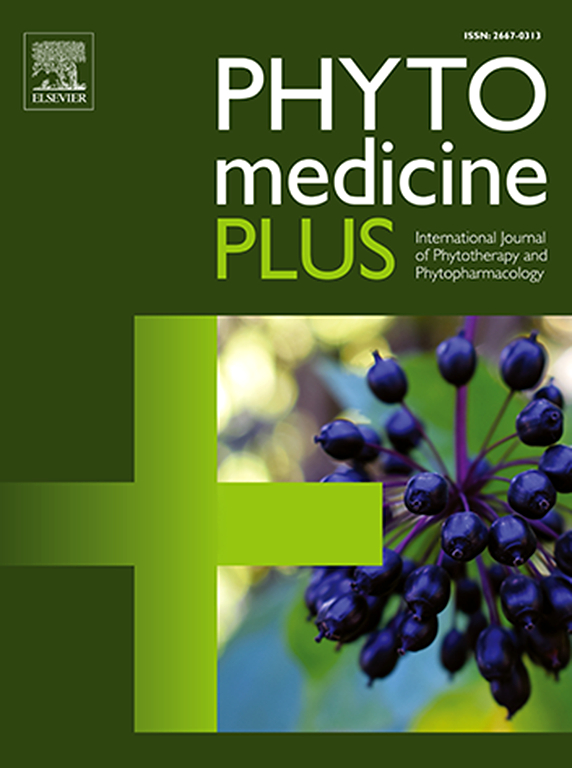端粒酶抑制植物化学物质来源的蓝花癌症治疗:一个全面的计算分析
Q3 Pharmacology, Toxicology and Pharmaceutics
引用次数: 0
摘要
癌细胞的一个潜在治疗靶点是端粒酶,这是一种与癌细胞寿命有关的重要酶。目前针对端粒酶的癌症治疗通常涉及具有明显副作用的合成药物,因此需要采用植物性治疗等替代方法。研究了12种用于癌症治疗的蓝花植物化学物质的抗端粒酶活性。方法采用Glide - Schrödinger、CB-Dock2(共价盲对接2)和Achilles盲对接的方法,研究端粒酶与植物化学物质的结合关系。为了进一步评估这些植物化学物质的相互作用和稳定性,并预测它们在生物环境中靶向端粒酶时的行为,我们使用Desmond-Schrödinger进行了分子动力学模拟。使用SwissADME和pkCSM(基于计算结构模型的药代动力学和毒性)进行的综合药代动力学分析通过确定这些植物化学物质的药物样质量支持了这些结果。该研究进一步使用癌症协同推荐算法(HRACS)确定协同治疗组合,其中某些植物化学物质对A549和MCF-7癌细胞系的端粒酶蛋白显示出增强的抗癌功效,表明组合治疗技术可能具有潜力。结果Tyrphostin AG494与端粒酶的结合亲和力最高,相互作用能最低,Glide - Schrödinger对接评分为-8.802 kcal/mol, CB-Dock2与Achilles盲对接评分为-8.5 kcal/mol。该植物化学物质还表现出强大的结合亲和力,通过与关键残基(如Asp251、Asp252、Ile252和Asp343)一致的镁金属离子相互作用介导,以及额外的氢键和水介导的接触,增强了其稳定性和选择性。此外,除西山马素外,所有植物化学物质均表现出各种药物样ADMET(吸收、分布、代谢、排泄和毒性)参数,并验证了Lipinski的五定律、Veber和Egan药物相似规则。结论tyrphostin AG494是抑制端粒酶最有效的天然植物化学物质,具有良好的结合亲和力和稳定性,ADMET特性强,毒副作用安全。因此,经过实验验证,Tyrphostin AG494是端粒酶抑制和癌症治疗中最合适和最有前景的候选者。本文章由计算机程序翻译,如有差异,请以英文原文为准。

Telomerase inhibiting phytochemicals derived from Blumea eriantha for cancer treatment: A comprehensive computational analysis
Background
One potential treatment target for cancer cells is telomerase, an essential enzyme involved in the longevity of cancer cells. Current cancer treatments targeting telomerase often involve synthetic drugs with significant side effects, necessitating alternative approaches such as plant-based therapeutics. This study investigates the anti-telomerase activity of twelve phytochemicals derived from Blumea eriantha for cancer treatment.
Methods
We examined the binding relationships between telomerase and the phytochemicals by performing molecular docking using Glide – Schrödinger, CB-Dock2 (Covalent Blind Docking 2), and Achilles Blind Docking. To further assess the interaction and stability of these phytochemicals and predict their behavior in a biological environment when targeting telomerase, we conducted molecular dynamic simulations using Desmond–Schrödinger. A comprehensive pharmacokinetic analysis using SwissADME and pkCSM (Pharmacokinetics and Toxicity by Computational Structure-based Models) supported these results by determining the drug-like qualities of these phytochemicals. The study further went on to identify synergistic treatment combinations using the Handy Recommendation Algorithm for Cancer Synergy (HRACS), where certain pairs of phytochemicals demonstrated enhanced anti-cancer efficacy against telomerase protein in A549 and MCF-7 cancer cell lines, suggesting that combinatorial therapy techniques may have potential.
Results
Among the phytochemicals evaluated, Tyrphostin AG494 demonstrated the highest binding affinity to telomerase, as evidenced by its lowest interaction energy, with a Glide – Schrödinger Docking Score of -8.802 kcal/mol and a CB-Dock2 and Achilles Blind Docking Score of -8.5 kcal/mol. The phytochemical also exhibited a robust binding affinity mediated by consistent magnesium metal ion interactions involving key residues such as Asp251, Asp252, Ile252, and Asp343, along with additional hydrogen bonding and water-mediated contacts that enhance its stability and selectivity. Furthermore, all the phytochemicals, except Quassimarin, demonstrated various drug-like ADMET (Absorption, Distribution, Metabolism, Excretion, and Toxicity) parameters and validated Lipinski's rule of five, Veber, and Egan drug-likeness rules.
Conclusion
Tyrphostin AG494 is the most effective natural phytochemical for inhibiting telomerase, exhibiting excellent binding affinity and stability, strong ADMET properties, and a safe toxicity profile. Therefore, following experimental validation, Tyrphostin AG494 is the most suitable and prospective candidate for telomerase inhibition and cancer therapy.
求助全文
通过发布文献求助,成功后即可免费获取论文全文。
去求助
来源期刊

Phytomedicine Plus
Medicine-Complementary and Alternative Medicine
CiteScore
3.70
自引率
0.00%
发文量
178
审稿时长
81 days
期刊介绍:
 求助内容:
求助内容: 应助结果提醒方式:
应助结果提醒方式:


